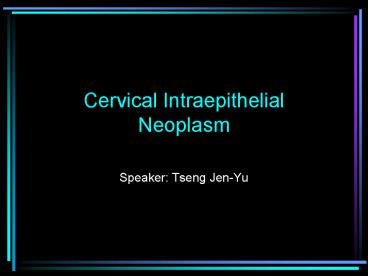Cervical Intraepithelial Neoplasm PowerPoint PPT Presentation
1 / 21
Title: Cervical Intraepithelial Neoplasm
1
Cervical IntraepithelialNeoplasm
- Speaker Tseng Jen-Yu
2
Introduction
- Cervical cancer was the most common malignancy in
both incidence and mortality among women prior to
the 20th century - Incidence fallen dramatically in developed
nations due to implementation of population based
screening, detection, and treatment programs for
pre-invasive disease
3
Epidemiology and Risk Factor
- 500,000 cases of cervical cancer diagnosed
- 2nd leading cause of cancer death
- Risk factors
- Sexually transmitted disease
- Human papilloma virus
- Multiple sexual partners
- Intercourse at early age
- Poor personal hygine
- Immunocompromise
- Cigarette smoking
4
Pathophysiology
- Transformation zone
- Area where glandular epithelium undergoes
squamous metaplasia - Metaplasia
- Occurs during fetal development / adolescence /
and first pregnancy - Columnar cells replaced by squamous cells
- Cells undergoing metaplasia are vulnerable to
carcinogens
5
Bethesda System
- LSIL
- Low grade squamous epithelial lesion
- HSIL
- High grade squamous epithelial lesion
- ASCUS
- Atypical squamous cells of undetermined
significance - AGUS
- Atypical glandular cells of undetermined
significance
6
Terminology and Definition
- CIN I
- Mild dysplasia ( lower 1/3 of epithelium )
- CIN II
- Moderate dysplasia ( 2/3 of epithelium )
- CIN III
- Severe dysplasia ( upper 1/3 of epithelium / CIS
) - Dysplasia
- Disorder maturation / Nuclear hyperchromatism
- Increased N/C ratio / Pleomorphism / Mitosis
7
(No Transcript)
8
CIN I
- Disease Profile
- Self limited sexually transmitted HPV infection
- 60 regress spontaneously
- 30 persistent
- 10 15 progress to CIN II / III
- 1 progress to invasive cancer
9
(No Transcript)
10
- Treatment
- Ablation ( cryotherapy / laser )
- Excision ( LEEP / Knife conization )
- Follow up without treatment
- Pregnant women
- Immunosuppressed women
- Adolescents
11
CIN II / III
- Disease Profile
- 43 untreated CIN II spontaneous regression
- 32 untreated CIN III spontanenous regression
- 35 CIN II will persist
- 56 CIN III will persist
- 22 CIN II progress to CIS or invasive cancer
- 14 CIN II progress to CIS or invasive cancer
12
(No Transcript)
13
- Treatment
- Ablation ( cryotherapy / laser )
- Excision ( LEEP / Knife conization )
- Follow up without treatment
- Pregnant women
- Adolescents
14
ASCUS
- Represent reactive / reparative changes secondary
to inflammation - 5 of routine Pap smears
- Treatment
- Repeat Pap smear in 4 6 months
- Colposcopy if repeat Pap shows ASCUS
15
AGUS
- Suspected glandular lesion that cant be
classified as reactive or neoplastic - Higher risk of neoplasia ( adenocarcinoma )
- 0.5 2.5 of routine Pap smear
- Treatment
- Colposcopy
- Conization ECC
16
Colposcopy
- Acetic acid
- coagulation of nuclear protein preventing light
to pass through the epithelium - Higher nuclear density and higher concentration
of protein gt white intensity increase
17
- Schiller / Lugols Iodine
- Normal, mature squamous epithelium contains
abundant glycogen - Produce dark brown stain
- Abnormal epithelium contains relatively little
or no glycogen - Remain relative unstained
18
Cryotherapy
- Indication
- Cytology / Colposcopy / ECC gt No microinvasion
- Lesion in ectocervix
- Criteria
- CIN I / II
- Small lesion
- Ectocervix
- ECC negative
- No endocervical gland involvement
19
Conization
- Indication
- Unsatisfactory colposcopy
- Evidence of premalignant or malignant glandular
epithelium - Microinvasion on biopsy / colposcopy / Pap smear
- HSIL ( CIN II / CIN III )
- Uncertainty regarding presence of microinvsaion
or invasion following direct biopsy for CIn - Inconsistent Pap smear and colposcopy
20
Cold Knife
- Indication
- Lesion extend to endocervical canal and extent
not possible to confirm - Extent exceeds capability of LEEP ( 1.5 cm )
- Cytology shows atypical glandular cells
- Colposcopy suggest glandular dysplasia or
adenocarcinoma - Abnormal endocervical curretage
21
Thank You for your attention

